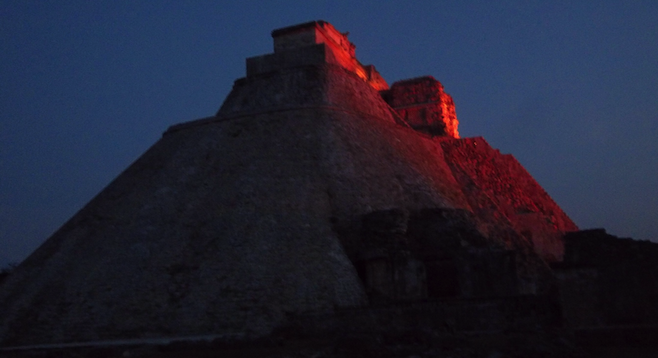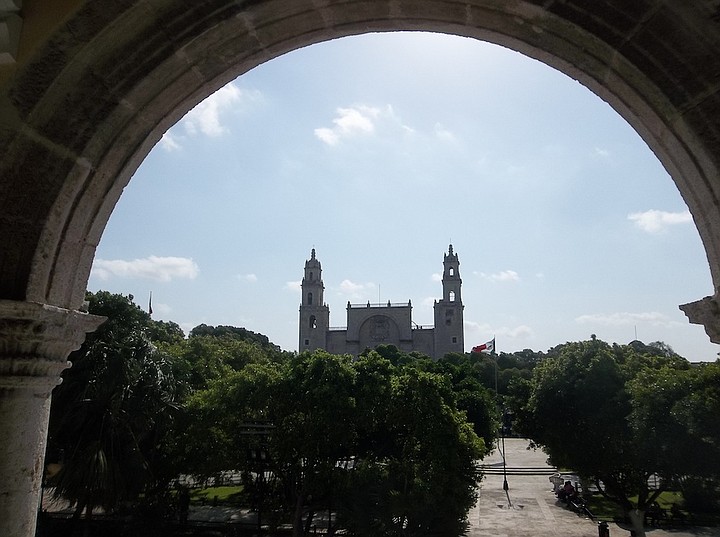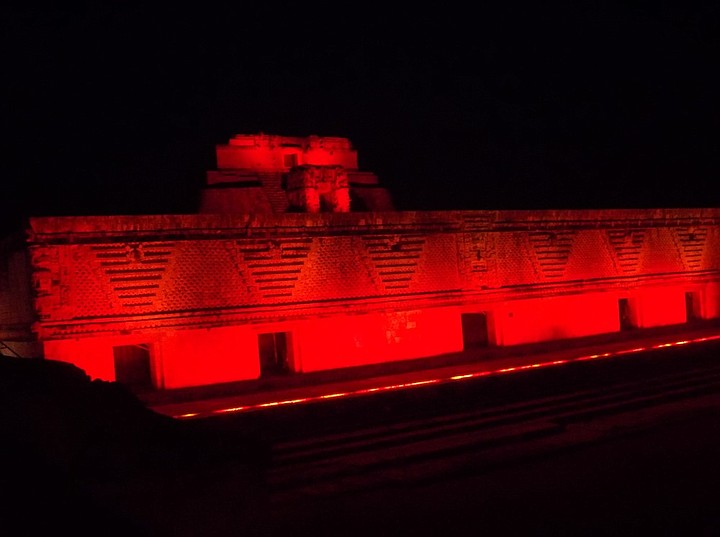 Facebook
Facebook
 X
X
 Instagram
Instagram
 TikTok
TikTok
 Youtube
Youtube

Although less well known than Chichen Itza, Uxmal is often preferred by travelers to the Yucatan. Located in the center-west of the peninsula, Uxmal is about an hour and 15 minute drive from Merida – a worthwhile town to explore in its own right and a convenient base for visiting other Maya sites.
Although I found Chichen Itza profoundly intriguing, a combination of jet lag, bus rides, lack of sleep, heat, crowds and pesky vendors left me exhausted at the end of a packed day. After all, it was only the previous morning that my red-eye flight had flown into Cancún from San Diego.
Yet I had another ambitious agenda for my second day in the Yucatan.

I decided to start off with a morning walking tour of Mérida. My big event for the day, though, the one that I had anticipated for months, would be an afternoon visit to Uxmal along with a stay for the evening Light and Sound Show.
After a good night’s rest, I was pleasantly surprised by the free walking tour offered at the tourist information booth in Merida’s plaza. Our engaging guide gave a great introduction to the highlights of Merida’s historical center. We were shown the inside of the Governor’s Palace and a stunning display of artwork depicting the struggles of locals in maintaining their traditions in the face of European intervention. The guide revealed she had learned the Maya language in school.
As with Native Americans in our country, many of the present-day indigenous Mayas struggle with poverty. It was disheartening to see impoverished Mayas begging at the entrance to the cathedral. The 1½-hour walk went by in a fascinating blur, leaving me enough time for a brief but welcome siesta after a lunch of delicious veggie enchiladas drenched in mole sauce.
When the guide for my Uxmal visit picked me up at my hotel, I soon discovered that I was the only English speaker in my group. No problema. The guide made a yeoman effort to keep me engaged in conversation in English. He offered a rich insight into Maya history and told me about several of the other sites in the Ruta Puuc, including Kabah, Sayil and Labna. He informed me that there was a Maya site at the location of modern Merida and that the Spanish destroyed it when they arrived.
Uxmal was a welcome contrast to Chichen Itza with its relaxed atmosphere and paucity of vendors. It’s one of the most interesting and best-preserved Maya sites in western Yucatan. The sculpted details of the ruins at Uxmal, an element of Puuc architecture, are some of the most beautiful of any Maya site.
Uxmal reached its zenith about 700 A.D. with about 20,000 people living here. Many of its structures have survived the centuries because of the sturdy Puuc style of construction (and a restoration in the 1930s).

The Pyramid of the Magician greets you as you enter the site. As with El Castillo at Chichen Itza, it’s prohibited to climb this nearly 30-meter-high pyramid. I simply gazed at it in awe. Our guide proceeded to demonstrate the acoustical phenomenon of the pyramid with claps and short calls that resulted in some chirped echoes (the sound of the quetzal bird?). He mentioned that, when Uxmal was occupied, only the priest went inside the temple. It was forbidden territory for regular folks.
The need for water was an obsession for the population of Uxmal. Locals would pray to Chaac, the rain god, for three months and would inevitably be rewarded with six months of rain. To underscore the extent to which the Uxmal people revered the rain god, hieroglyphcs reveal that an Uxmal ruler took the name “Lord Chac” about 900.

We further explored the site with memorable stops at the Nunnery, the Governor’s Palace and the ballcourt. The Uxmal Nunnery, site of the evening light show, is a well preserved quadrangle of buildings whose function is a mystery. Some speculate it may have served as a governmental and administrative center. Others believe it may have been a palace or served as residences for priests or soldiers. It may have even served as a dorm for Maya students.
The Governor’s Palace was the last structure we visited at Uxmal. It’s a long, elegantly sculpted building, with ornate carvings of serpents, lattices, masks, and a god-like figure with a long, plumed headdress. The building is considered to be perhaps the finest example of Puuc style architecture in Mesoamerica.
The Light and Sound Show at night in Uxmal was a transcendent experience. Colored lights illuminate the ruins. Headphones allow you to hear the narration in English, if your Spanish isn't up to par.
The show originated in 1975 with much fanfare. Queen Elizabeth II and other dignitaries visited to mark the occasion. The Maya gods must have a sense of humor, because just as the chant to the rain god, Chaac, began, the skies opened and a sudden downpour drenched everyone – and it was the dry season!
Such an event did not happen while I was there, but it was still surreal to see lightning flash in the distance as the ruins were lit up and the rain chant played. Once you're seated under the Yucatan stars, you need only sit back and let the wonder and intrigue of this civilization wash over you.


Although less well known than Chichen Itza, Uxmal is often preferred by travelers to the Yucatan. Located in the center-west of the peninsula, Uxmal is about an hour and 15 minute drive from Merida – a worthwhile town to explore in its own right and a convenient base for visiting other Maya sites.
Although I found Chichen Itza profoundly intriguing, a combination of jet lag, bus rides, lack of sleep, heat, crowds and pesky vendors left me exhausted at the end of a packed day. After all, it was only the previous morning that my red-eye flight had flown into Cancún from San Diego.
Yet I had another ambitious agenda for my second day in the Yucatan.

I decided to start off with a morning walking tour of Mérida. My big event for the day, though, the one that I had anticipated for months, would be an afternoon visit to Uxmal along with a stay for the evening Light and Sound Show.
After a good night’s rest, I was pleasantly surprised by the free walking tour offered at the tourist information booth in Merida’s plaza. Our engaging guide gave a great introduction to the highlights of Merida’s historical center. We were shown the inside of the Governor’s Palace and a stunning display of artwork depicting the struggles of locals in maintaining their traditions in the face of European intervention. The guide revealed she had learned the Maya language in school.
As with Native Americans in our country, many of the present-day indigenous Mayas struggle with poverty. It was disheartening to see impoverished Mayas begging at the entrance to the cathedral. The 1½-hour walk went by in a fascinating blur, leaving me enough time for a brief but welcome siesta after a lunch of delicious veggie enchiladas drenched in mole sauce.
When the guide for my Uxmal visit picked me up at my hotel, I soon discovered that I was the only English speaker in my group. No problema. The guide made a yeoman effort to keep me engaged in conversation in English. He offered a rich insight into Maya history and told me about several of the other sites in the Ruta Puuc, including Kabah, Sayil and Labna. He informed me that there was a Maya site at the location of modern Merida and that the Spanish destroyed it when they arrived.
Uxmal was a welcome contrast to Chichen Itza with its relaxed atmosphere and paucity of vendors. It’s one of the most interesting and best-preserved Maya sites in western Yucatan. The sculpted details of the ruins at Uxmal, an element of Puuc architecture, are some of the most beautiful of any Maya site.
Uxmal reached its zenith about 700 A.D. with about 20,000 people living here. Many of its structures have survived the centuries because of the sturdy Puuc style of construction (and a restoration in the 1930s).

The Pyramid of the Magician greets you as you enter the site. As with El Castillo at Chichen Itza, it’s prohibited to climb this nearly 30-meter-high pyramid. I simply gazed at it in awe. Our guide proceeded to demonstrate the acoustical phenomenon of the pyramid with claps and short calls that resulted in some chirped echoes (the sound of the quetzal bird?). He mentioned that, when Uxmal was occupied, only the priest went inside the temple. It was forbidden territory for regular folks.
The need for water was an obsession for the population of Uxmal. Locals would pray to Chaac, the rain god, for three months and would inevitably be rewarded with six months of rain. To underscore the extent to which the Uxmal people revered the rain god, hieroglyphcs reveal that an Uxmal ruler took the name “Lord Chac” about 900.

We further explored the site with memorable stops at the Nunnery, the Governor’s Palace and the ballcourt. The Uxmal Nunnery, site of the evening light show, is a well preserved quadrangle of buildings whose function is a mystery. Some speculate it may have served as a governmental and administrative center. Others believe it may have been a palace or served as residences for priests or soldiers. It may have even served as a dorm for Maya students.
The Governor’s Palace was the last structure we visited at Uxmal. It’s a long, elegantly sculpted building, with ornate carvings of serpents, lattices, masks, and a god-like figure with a long, plumed headdress. The building is considered to be perhaps the finest example of Puuc style architecture in Mesoamerica.
The Light and Sound Show at night in Uxmal was a transcendent experience. Colored lights illuminate the ruins. Headphones allow you to hear the narration in English, if your Spanish isn't up to par.
The show originated in 1975 with much fanfare. Queen Elizabeth II and other dignitaries visited to mark the occasion. The Maya gods must have a sense of humor, because just as the chant to the rain god, Chaac, began, the skies opened and a sudden downpour drenched everyone – and it was the dry season!
Such an event did not happen while I was there, but it was still surreal to see lightning flash in the distance as the ruins were lit up and the rain chant played. Once you're seated under the Yucatan stars, you need only sit back and let the wonder and intrigue of this civilization wash over you.
Comments